What's inside
Functional strength training is a term we hear in fitness media and marketing, as well as among industry professionals.
The problem is, functional training often gets thrown around without more explanation about what it is and how it can benefit you.
So, what is functional strength training? Is it something you should consider including in your training program?
You’ll find it’s more than a powerful buzzword.
As a personal trainer, I help athletes and others use functional strength training to get their best results, whether they’re on the field or just want to keep up with their kids.
Today, I’m going to share what functional strength training is, the benefits, and a workout to help you make it a part of your training.
Let’s jump in.
What is functional strength training?
Related: Hypertrophy Vs Strength Training
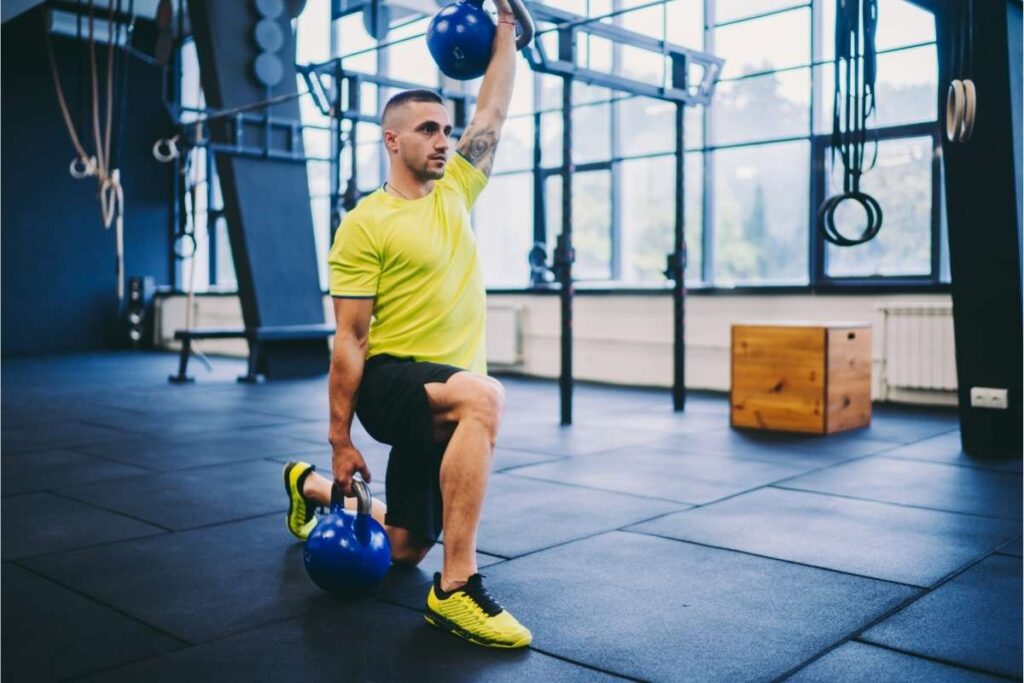
Functional strength training is a style of training that incorporates exercises and movements that will help improve function and performance.
For example, a high jumper improving their explosive power with plyometric exercises. Or, a soccer player improving their train change of direction with agility circuits.
Even non-lifters can use functional training if they want to work on their lifting capacity.
Who is functional strength training for?
Function strength training is for everyone who wants to improve their quality of life.
While it has been mainly used for athletes in the past, the boom of fitness culture has seen everyday people reap the rewards of improving their strength in their daily lives.
What are the core elements of functional strength training?
Functional strength training’s core elements are based on the individual’s daily or recreational demands. It’s typically built around compound movements.
This can be squats for someone who needs assistance sitting down or standing up.
Laborers who need to correct their technique at work can perform deadlifts. Or, add dumbbell presses to lunges to add lower-body power and stability to overhead lifting.
All of these movements are functional strength exercises that enhance our movements based on our needs.
What are the benefits of functional strength training?
Anything you like to do with your body can be made better with functional strength training.
Here are some of the bigger benefits of including functional training exercises in your workout.
Improve Daily Function
Resistance training has long been identified as a way to improve strength.
Research identifies that regular strength training can improve the quality of the movement and reduce pain in the body.
Further studies indicate that functional strength exercises are beneficial in improving aspects such as balance and fall reduction.
Improve Performance
Related: Pride Pre Workout Review
Functional strength training has long been used to enhance athletic performance.
Research has shown that functional training exercises are a great way to improve power, speed, strength, agility, and balance.
Increase Training Variety
Functional movement exercises add variety to your training.
When we approach the gym, we can get stuck in the habit of using the same equipment and machines.
Functional strength training combines exercises like pressing squats and lunges with twists.
This helps you stack your exercises, and target more muscle groups.
Prevent Injury
Functional strength training similar to traditional strength training can be beneficial in the treatment and prevention of injuries.
Research has long been used to rehabilitate injury and reduce pain.
Additional data suggests that resistance training can help in injury prevention as well as recovery.
Increase Bone Density
As we age, our bone density naturally decreases, leaving us at risk of fracture from falls or accidents.
Functional strength exercises and resistance training have been shown to be beneficial in reducing osteoporotic fractures in older adults.
Research has noted an increased bone mineral density with regular resistance training.
What is the difference between functional and traditional strength training?
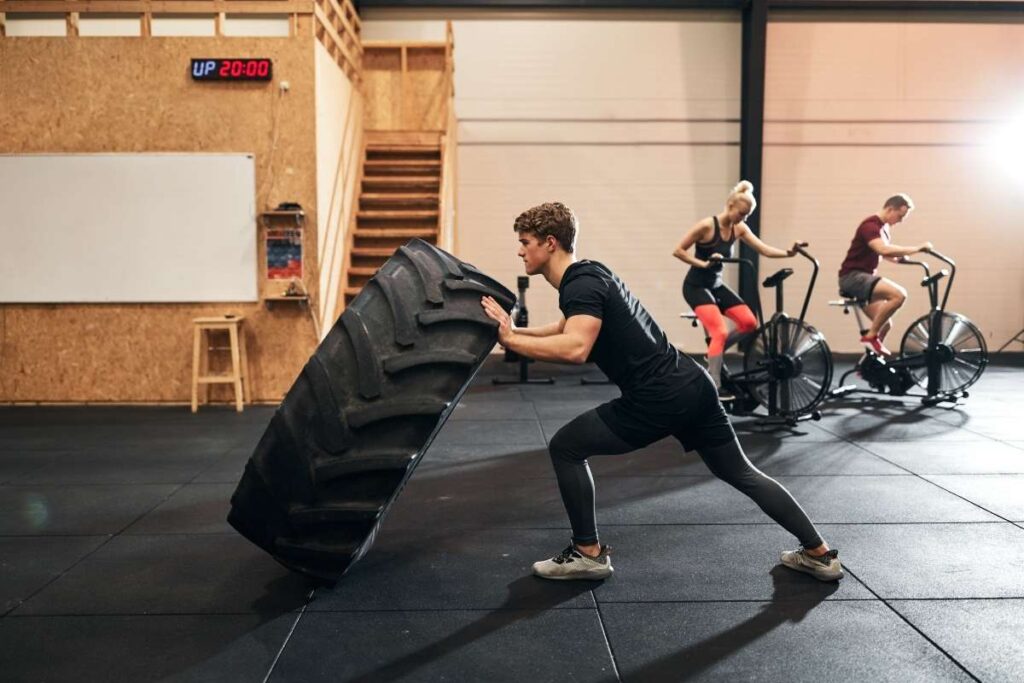
Functional training strength training is built around improving movement and function. Strength training is created around certain lifts or muscle groups.
An example of this is tire flipping. It’s a compound movement focused on purposefully lifting weight.
Compare this to a bicep curl, which is solely focused on increasing the mass of a specific muscle.
Movements such as squats and deadlifts can fit into both camps as they are considered to be daily movements as well as targeting specific muscles.
Functional Strength Training vs. HIIT
Functional strength training replicates bodily movements.
HIIT is a style of training that is used to elevate heart rate and metabolic conditioning.
14 Best Exercises To Include In Your Functional Strength Training
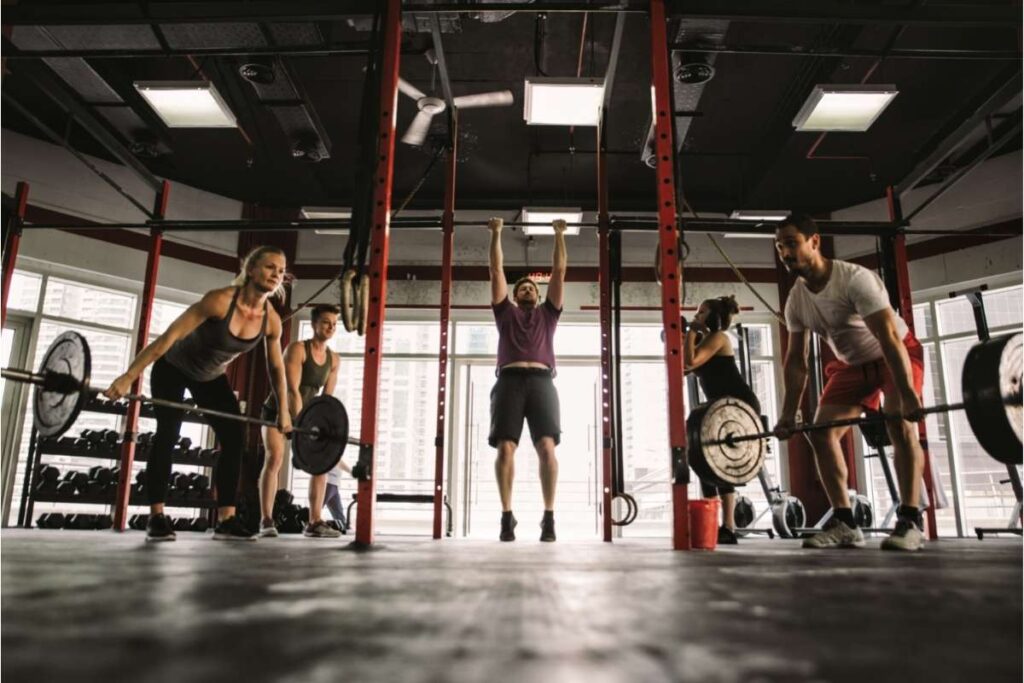
Below is a list of exercises to add to your functional strength training program.
1. Hip Raises
Hips raises are one of the most effective movements any lifter can perform in the gym. Simple in appearance, their benefits translate to all movement patterns.
Hip raises target the muscles of the hips, with a focus on the glutes. This exercise is essential for all gym goers.
Equipment Requirements
- Floor Space
- Mat
How To Perform Hip Raise
- Lying on your back, place feet shoulder-width apart with knees bent at 90 degrees.
- Engage glutes and lift hips up toward the ceiling.
- Lift until legs are in line with the torso.
- Pause for a second, then gradually lower back down to the mat. Repeat.
Benefits
- Activates and strengthens glute
- Trains hip hinge movement
Pro Tips
- When performing the hip thrust, focus on lifting the hips rather than pushing through the legs. This will help you isolate the glutes.
- Be sure to lift until hips are in line with the torso. This will increase the contraction of the glutes.
2. Dumbbell Squat Press
The squat press is one of the best full-body movements in the gym.
By pressing through the legs and over the head, we train to push through the entire body.
Equipment Requirements
- Dumbbells
How To Perform Dumbbell Squat Press
- Standing, lift dumbbells up to the front rack position with elbows up.
- Begin by unhinging your hips and lowering yourself down toward the ground.
- Lower until hips are parallel with the floor.
- Once you reach the bottom, drive up through the legs and simultaneously push dumbbells up into the air.
- Gradually lower dumbbells back down to the front rack position. Repeat.
Benefits
- Full-body press movement
- Teaches and strengthens the ability to push using legs and arm
Pro Tips
- When performing the upward and pressing phase, use the power of the legs to generate momentum to press overhead.
- Focus on breathing – inhale and engage your core as you lower yourself into the squat. Exhale when pushing out of the squat and dumbbells overhead.
3. Barbell Deadlifts
Related: Hook Grip Deadlift
The king of all strength exercises, barbell deadlifts are also an amazing functional movement.
Deadlifting is complex, using both pull movements of the arms and upper back as well as push through the hips and legs.
It teaches us the correct lifting technique and is a great way to build size and strength.
Equipment Requirements
- Barbell
- Weight Plates
How To Perform Barbell Deadlifts
- Standing in front of a barbell positioned directly over shoelaces.
- Lean forward at the hips and grab the bar.
- Allow knees to bend and drop hips slightly down.
- Gently pull the bar and engage the shoulder blades back and down toward the hips, creating tension through the body.
- To begin, push through the legs and pull the bar up to the knees.
- Once the bar passes the knees, push forward hips until you reach the upright position.
- From here, lean forward at the hips and slowly lower the bar.
- Once the bar passes the knees, allow the knees to bend until the bar reaches the floor. Repeat.
Benefits
- Teaches and strengthens correct lifting technique
- Great for strength and mass
Pro Tips
- Before lifting, gently pull the bar and squeeze the lats down toward the pelvis. This will help create tension in the body from the start.
- Focus on breathing, inhaling as you lower and exhaling as you lift.
4. Walking Lunges
The walking lunge is not only a functional movement; it’s a great way to teach the lunge.
Lunging is a versatile exercise that helps us build unilateral strength, which can be beneficial to improving overall strength and balance.
Equipment Requirements
- Dumbbells (if required)
How To Perform Walking Lunges
- Standing upright, take a step with one foot into the split stance.
- Lower your back knee directly down to the ground until both front and back knees are bent at 90 degrees.
- Push up with both legs, and have the back leg take a step forward to meet the leading leg. Repeat.
Benefits
- Builds unilateral strength
- Improves stability and balance
Pro Tips
- When lunging, drop the back knee to the floor. This will help evenly load your joints.
- Keep each leg in its own lane and avoid walking on a tightrope. This will help to improve balance.
5. Reverse Lunge Press
The reverse lunge press is an example of movement stacking, in which we combine two movements into one exercise.
By performing a reverse lunge and holding it while we complete a press, our body must isometrically contract to stabilize.
Equipment Requirements
- Dumbbells (if required)
How To Perform Reverse Lunge Press
- Position the dumbbells up in the front rack position with elbows high.
- Begin by taking a step back with one foot and drop the back knee directly down to the floor.
- Lower until both knees are bent at 90 degrees, without the back knee touching the floor.
- Using the dumbbells, perform a pressing movement directly overhead.
- Lower the dumbbells back down to the rack positions.
- Push up through both legs and return the back leg to the starting position.
- Alternate legs. Repeat.
Benefits
- Full-body exercises that combine pressing and lunging
- Improves balance
Pro Tips
- For beginners, start with a shallower range of motion. This will make it easier to hold your lunge while you press overhead.
- Engage core during each rep. This will help improve balance, which is essential when performing the overhead press.
6. Dumbbell Clean And Press
Related: Top 10 Lower Back Exercises With Dumbbells
The dumbbell clean and the press is a functional movement exercise that uses the body’s momentum to lift weight overhead.
Equipment Requirements
- Dumbbells
How To Perform Dumbbell Clean And Press
- Stand with a dumbbell in each hand at your sides.
- Unhinge at the hips and knees and perform a small quarter squat bounce.
- Thrust hip forward and use the momentum to swing dumbbells up to the front rack position.
- Unhinge at the hip again, push through with hips and leg, and press dumbbells overhead.
- Return to the upright position, and gradually lower the dumbbells back down to the side of your body. Repeat.
Benefits
- Develop push and pull power
- Full-body movement
Pro Tips
- Generate power using legs and hips to clean the dumbbells and press them overhead.
- Before each movement, inhale and engage the core while exhaling with the clean and press movements.
7. Farmer’s Walk
The farmer’s walk, or farmer’s carry, is likely the most simple exercise on this list. However, its ability to engage the entire body and teach the correct carrying technique is unmatched.
Equipment Requirements
- Dumbbells
How To Perform Farmer’s Walk
- Stand with dumbbells in hands at your sides.
- Gently engage shoulder blades back and down, and tense core.
- Walk your designated carry length up and back. Repeat.
Benefits
- Improves carry and grip strength
- Full-body exercise
Pro Tips
- Engage upper back muscles by pulling shoulder blades back and down. This will help the load.
- Concentrate on breathing and tensing abs throughout the entire carry. This will help control the load.
8. Push-Ups
A staple in any bodyweight workout, the push-up is in fact a functional movement.
Being able to get up off the floor is a skill that is highly underrated and is lost as we age. Continuing to practice push-up movements is essential to our function.
Equipment Requirements
- Dumbbells
How To Perform Push-Ups
- Place hands on the floor slightly wider than shoulder-width apart, directly below shoulders.
- Keep feet shoulder-width apart on your toes.
- Begin by bending your elbows and lowering your chest toward the floor.
- Lower until your elbows are bent at 90 degrees.
- Once you reach the bottom, push up with your arms to the starting position. Repeat.
Benefits
- Full-body movement
- Improves push-related movements
Pro Tips
- When performing the push-up, keep the core engaged and hips parallel with the floor. This will help use the muscles of the entire body to perform the movement.
- Focus on breathing, inhaling as you lower and exhaling as you push up.
9. Chin-Ups
The chin-up is one of the best upper body movements to engage our arms, back, and abdominals.
Teaching us how to pull ourselves up makes it a functional movement.
Equipment Requirements
- Chin-Up Bar
How To Perform Chin-Ups
- Directly under a chin bar, grab the bar using an underhand grip with a hand shoulder-width apart.
- With a proud chest, pull your body up toward the bar until the bar meets your collarbone.
- Once you reach the top, slowly release and lower your body to the starting position. Repeat.
Benefits
- Strengthen pull motion
- Targets the arms, abdominals, and back
Pro Tips
- When performing the pull-up, focus on pulling elbows back and down. This will help draw focus to the muscles of the back.
- Activate abs and focus on your breathing, inhaling as you lower yourself and exhaling as you pull yourself up.
10. Kettlebell Swings
Related: 12 Week Kettlebell Program
Kettlebell swings are great exercises for teaching us momentum generation through the hips.
This can be beneficial for other movements in the gym and when lifting objects in daily life.
Equipment Requirements
- Kettlebell
How To Perform Kettlebell Swings
- Hold the kettlebell between the legs with both hands.
- Unhinge hips and knees and lean forward slightly at the hips.
- Push through the legs and thrust hips forward to create momentum.
- While holding the kettlebell, allow it to swing up into the air in front of you until it meets eye level.
- Allow the kettlebell to swing back down and repeat the movement to a continuous momentum for the duration of the set.
Benefits
- Develops power through the hips
- Improves performance
Pro Tips
- When swinging the kettlebell, allow it to drop. This helps create a pendulum effect that is necessary to perform the exercise.
- Focus on thrusting through the hips to generate momentum.
11. Burpees
The burpees are likely one of the least favorite exercises on this list. However, it is a functional movement that again, teaches us how to get up and down off the floor.
Equipment Requirements
- Floor Space
How To Perform Burpees
- Standing, bend forward, place hands on the floor, and kick legs back.
- Lower yourself toward the floor until your body makes contact with the floor.
- Once you make contact, push up with your arms and launch your feet forward toward your hands.
- Stand upright and jump into the air.
- Land with soft knees. Repeat.
Benefits
- Full-body movement
- Increase heart rates
Pro Tips
- Focus on breathing, inhaling as you lower yourself to the floor and exhaling as you push up and jump into the air.
- Aim to move continuously throughout the set. This will help maintain momentum through the set.
12. Burpees to Chin-Ups
Take the least favorite movement on this list and add a pull-up.
The burpee chin-up combines two incredible functional movements into the best exercise to hit every muscle in your body.
Equipment Requirements
- Floor Space
- Chin-Up Bar
How To Perform Burpees To Chin
- Standing facing toward a chin-up bar, bend forward at the hips and place hands on the floor.
- Kick your legs back to assume the push-up position and lower your body toward the floor.
- Once your body makes contact with the floor, push yourself up off the floor.
- Stand up and jump into the air.
- Grab the chin-up bar and lift your body up toward the bar.
- Pull up until your collarbone meets the chin-up bar.
- Gradually lower and drop back down to the floor. Repeat.
Benefits
- Full-body movement
- Increase heart rates
Pro Tips
- Control breathing throughout the movement, inhaling as you lower and exhaling as you push up, jump, and pull up.
- Use the momentum of your jump to help you lift yourself into the pull-up. This will help when you are fatigued and need assistance to complete the full range of motion.
13. Renegade Row
Renegade rows are a full-body movement that allows us to train our arms and upper back while engaging our core and hip stabilizers.
Equipment Requirements
- Floor Space
- Dumbbells
How To Perform Renegade Row
- Holding a pair of dumbbells, assume the push-up position with shoulders directly over hands and weight on your toes.
- Lower your body down toward the floor until your elbows are bent at 90 degrees.
- Push yourself up until you reach the starting position.
- Row one dumbbell back, keeping your elbow tucked to the side of your body.
- Row until the thumb makes contact with your ribcage.
- Once the row is completed, lower dumbbell and row with the other hand. Repeat.
Benefits
- Full-body movement
- Engages core while working back
Pro Tips
- Focus on breathing, exhaling when pushing up and rowing. This will create stability throughout the body.
- For beginners, position feet slightly wider than shoulder-width apart. This will help you balance.
14. Single-Leg Deadlift
The single-leg deadlift is a fantastic movement to improve unilateral strength and balance.
Equipment Requirements
- Dumbbell
How To Perform Single-Leg Deadlift
- Standing with a dumbbell in one hand, lift the same-side leg off the floor.
- Lean forward at the hips and allow the lifted leg to lift further back behind you.
- Continue bending forward until your torso and lifted leg are parallel with the floor.
- Once you reach this position, lift up with the torso as the rear leg returns to the floor.
- Complete all reps on this side and switch sides.
Benefits
- Builds unilateral hips and leg function
- Teaches correct lifting for small objects
Pro Tips
- When bending forward at the hips, try to keep the rear leg straight and in line with the torso. This will act as a counter-weight for your body moving forward and improve balance.
- Between each repetition, gently plant the lifted leg, rest, and regain your balance. This will help you improve your form.
The Best Functional Strength Training Program
Related: Virtual Personal Trainer
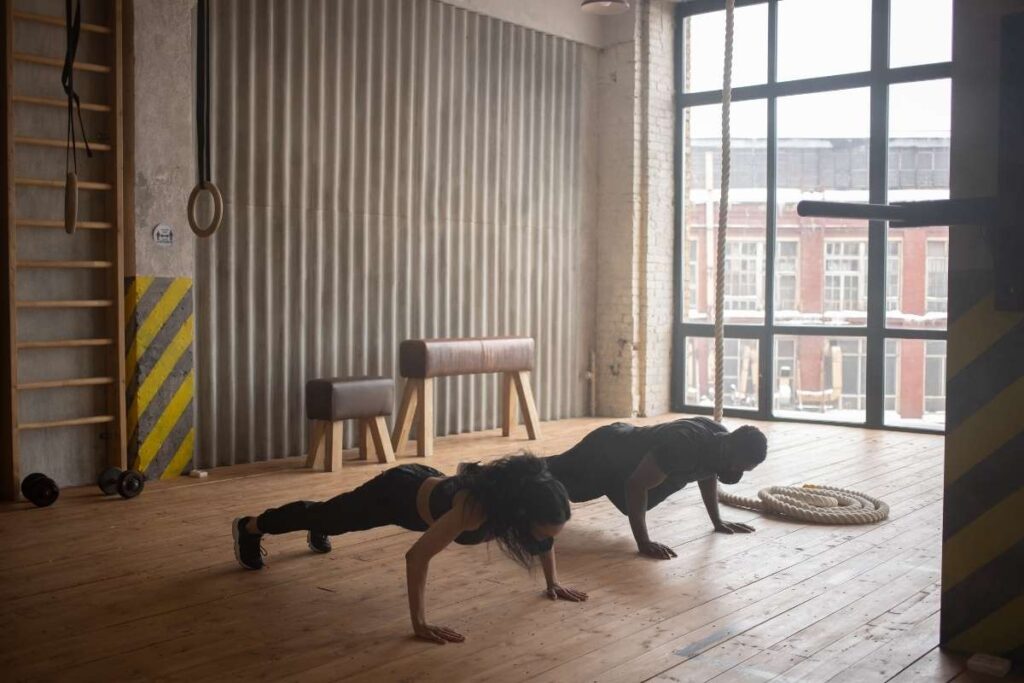
Below are two functional strength training programs for beginner and advanced levels, complete with a weekly schedule to ensure you’re getting enough rest between sessions.
Functional Strength Training Schedule
| Mon | Tue | Wed | Thurs | Friday | Sat | Sun |
| Train | Rest | Train | Rest | Train | Rest | Train |
Beginner Workout
| Exercise | Sets | Repetitions | Rest Time |
|---|---|---|---|
| Hip Raises | 3 | 12 | 45 – 60 secs |
| Walking Lunges | 3 | 20 | 45 – 60 secs |
| Deadlift | 3 | 10 | 60 secs |
| Push-Ups | 3 | 8-10 | 45 secs |
| Mini Circuit | 90 sec between rounds | ||
| Burpee | 2 | 8-10 | |
| Kettlebell Swing | 2 | 8-10 | |
| Farmer’s Carry | 2 | 80 ft |
*Mini circuit exercises to be completed in succession with no rest in between. Once each exercise is performed once, a 90-second rest can be taken.
Advanced Workout
| Exercise | Sets | Repetitions | Rest Time |
| Dumbbell Squat Press | 3 | 12 | 45 – 60 secs |
| Reverse Lunge Press | 3 | 12 | 45 – 60 secs |
| Deadlift | 3 | 12 | 60 secs |
| Dumbbell Clean and Press | 3 | 10 | 45 secs |
| Burpee to Chin-Ups | 3 | 8 | 60 secs |
| Renegade Rows | 3 | 8-10 | 60 secs |
| Kettlebell Swings | 3 | 12-15 | 45 secs |
| Farmer’s Carry (Heavy) | 3 | 150 ft | 60 secs |
What are examples of functional strength training?
Related: Top 10 Inner Thigh Exercises
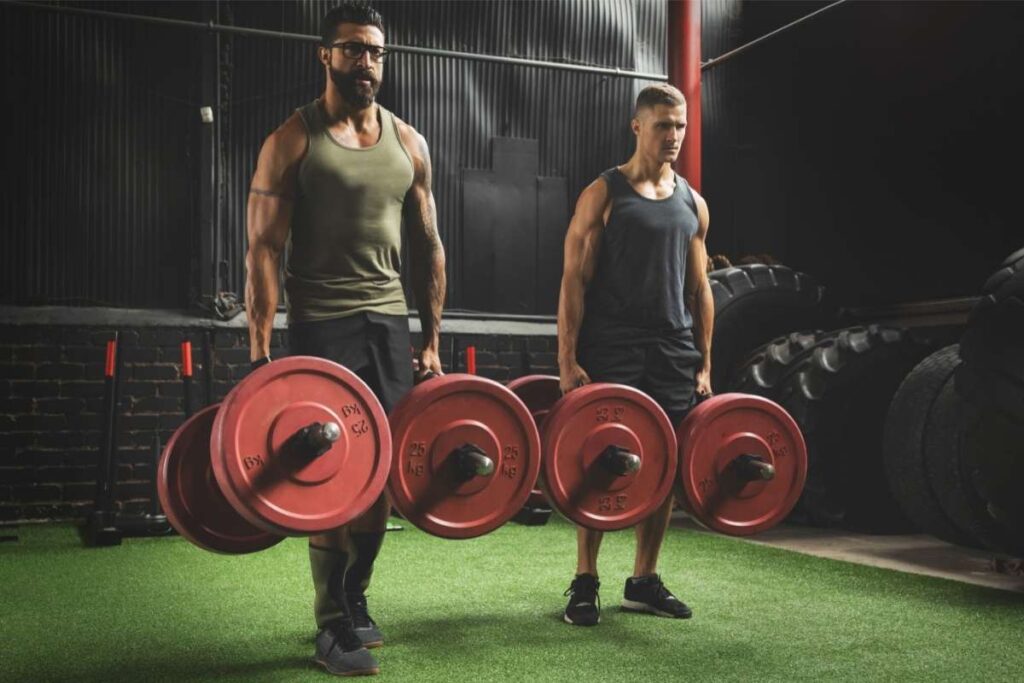
Functional strength training consists of compound movements that use multiple joints throughout the body.
These are exercises like deadlifts for teaching and strengthening the correct lifting techniques.
Squats can improve leg strength and the ability to sit down and stand up.
Combining movements such as the squat press allows us to train the ability to push with our legs to move weight above our heads.
What is considered functional strength?
Functional strength is the ability to take our body’s joints through their full range of motion without restriction or pain.
Final Thoughts
Everyone can benefit from functional strength training.
It’s perfect for people who want to build muscle, athletes who want to improve performance, and anyone who wants to combat reduced mobility as they age.
If you have any physical goal, make it a priority. People who work tough jobs can use it to prevent common lower back injuries. Those who want to get in shape reliably and keep it that way can start at home today.
What kind of functional strength training exercises do you do most? If none, are you thinking of adding functional movement exercises to your training?
Let us know in the comments below, and share this article with someone who needs it.

